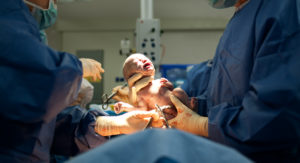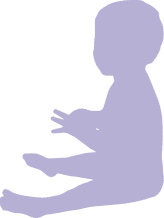What Are the Most Common Medical Mistakes That Lead to Birth Injuries?
 There are many different causes of birth injuries. Some are natural and beyond anyone’s control. For example, a very large baby can cause complications during delivery if they can’t fit through the birth canal.
There are many different causes of birth injuries. Some are natural and beyond anyone’s control. For example, a very large baby can cause complications during delivery if they can’t fit through the birth canal.
Sadly, errors made by doctors, nurses, and other medical professionals may also lead to many birth injuries. These mistakes can occur before, during, or shortly after delivery.
One medical error can cause a child to suffer lifelong health problems.
Here is a look at some common medical mistakes that lead to birth injuries:
During Pregnancy
Not all birth injuries occur during childbirth. Some birth injuries happen because a doctor or other medical professional failed to screen or treat the mother for health conditions that placed her and her baby at risk.
Maternal conditions that can cause birth injuries when left untreated include:
- Diabetes
- High blood pressure (preeclampsia)
- Maternal infection
- Obesity
During Delivery
Obstetricians and members of an expectant mother’s care team have been trained to deliver babies in all situations, including when there are complications. However, the results can be tragic when there is poor communication between delivery team members or if a doctor flat out makes a medical mistake.
Medical errors during delivery that can lead to birth injuries include:
- Delayed delivery
- Failure to notice fetal distress
- Failure to recognize the baby is positioned feet or bottom first (breech)
- Forcefully yanking on a baby as they exit the birth canal
- Improper use of forceps or vacuum extraction
- Performing a vaginal birth instead of a medically necessary C-section (cesarean section)
- Slow response to an emergency
All of the above can cause serious injury to the mother and baby. In some cases, birth trauma can lead to permanent brain damage in the child and even death.
After Childbirth
Even after a child has been delivered, a doctor or nurse can make a medical mistake that can cause a severe birth injury. Medical professionals are supposed to monitor the infant and mother after birth and look for signs of complications. When they fail to do so, the results can be devastating.
Medical errors that can occur soon after birth include:
- Failure to control blood loss
- Failure to diagnose and treat newborn jaundice
- Failure to monitor the infant’s vital signs and oxygen levels
- Failure to test the mother and baby for blood type incompatibility
Indeed, many other medical mistakes can lead to birth injuries. If you suspect a preventable medical error caused your child’s birth injury, a skilled birth injury lawyer may be able to help.
A birth injury attorney is a type of personal injury lawyer who specializes in medical malpractice claims.
Get a free case review to find out if you may be eligible for financial assistance.
Types of Birth Injuries Caused by Medical Mistakes
Medical mistakes before, during, and soon after birth can lead to many different types of birth injuries. Common birth injuries include:
Brain Damage
When the brain does not get enough oxygen, brain damage can occur. A total lack of oxygen to the brain is an anoxic brain injury. In contrast, a reduced oxygen supply causes a hypoxic brain injury.
It can be scary when your child suffers brain damage from a birth injury. However, babies can recover from mild cases of brain damage. Sadly, when the damage is more severe, children often develop serious health conditions that can affect them for the rest of their lives.
A doctor who fails to monitor a baby’s oxygen levels before and during delivery can cause damage to a newborn’s developing brain.
Cerebral Palsy (CP)
Cerebral palsy is a group of neurological disorders that affects a person’s movement, balance, and posture. It is the most common childhood motor disability. Symptoms differ from person to person. One person with CP, for example, might need aids to walk while another person might not.
Many people with CP also have other health conditions like intellectual disabilities, seizures, and speech and hearing problems.
An obstetrician who misuses forceps, waits too long to respond to fetal distress, or fails to treat a maternal infection can cause CP.
Erb's Palsy
Erb’s palsy, also known as brachial plexus palsy, occurs when the nerves that feed the arms and hands are injured.
When a doctor has difficulty delivering a baby’s shoulder (shoulder dystocia), Erb’s palsy is likely to occur.
Infants with a brachial plexus injury have problems flexing and rotating the injured arm. Many babies with this condition heal on their own. Unfortunately, others with torn nerves may end up with permanent nerve damage.
Hypoxic Ischemic Encephalopathy (HIE)
HIE, short for hypoxic ischemic encephalopathy, is a type of brain dysfunction that happens when the brain does not get enough oxygen or blood flow. The amount of brain damage usually depends on how long the brain is without oxygen.
Additionally, HIE can cause damage to the heart, liver, and other vital organs.
Some children will have no health problems, while others may experience severe and permanent disabilities, including cerebral palsy and developmental delays.
Medical professionals who fail to treat a maternal infection, monitor fetal distress, or prevent prolonged labor place babies at risk for HIE.
Signs and Symptoms of Birth Injury Caused by Medical Mistakes
Although some birth injuries can be easy to spot, others can go undetected for months or even years after childbirth.
Some signs of birth injuries include:
- Breathing problems
- Cuts, bruises, or swelling on the baby’s face or head
- Lack of muscle tone or “floppy” appearance
- One arm that seems limp
- Pale or bluish skin tone
- Seizures
- An inability to crawl, sit up, and walk
- Feeding issues
- Hearing or vision problems
- Muscle control and coordination issues
A child failing to hit a developmental milestone could also signal a birth injury.
If you are worried that something might be wrong with your child, get medical care as soon as possible. Early treatment can be vital to treating a birth injury.
IS YOUR CHILD MISSING DEVELOPMENTAL MILESTONES?
Take Our Milestones Quiz
Taking note of your child’s physical, social, and emotional skills can help you determine if they potentially suffered from an injury at birth. An early diagnosis can help your child get the treatment they need as soon as possible.
Q1: How old is your child?
0-2 MONTHS DEVELOPMENTAL MILESTONES QUIZ
- Q2: Can your child hold their head steadily on their own?
- Q3: Can your child push themselves up when they are lying on their stomach?
- Q4: Has your child started to make smoother movements with their arms and legs?
- Q5: Does your child smile at other people?
- Q6: Can your child bring their hands to their mouth?
- Q7: Does your child turn their head when they hear a noise?
- Q8: Does your child coo or make gurgling noises?
- Q9: Does your child follow things with their eyes?
- Q10: Does your child try to look at their parents or caregivers?
- Q11: Does your child show boredom, cry, or fuss when engaged in an activity that hasn’t changed in a while?

3-4 MONTHS DEVELOPMENTAL MILESTONES QUIZ
- Q2: Can your child hold their head steadily on their own?
- Q3: Does your child push down on their legs when their feet are on a flat surface?
- Q4: Has your child started to roll over from their stomach to their back?
- Q5: Can your child hold and shake a toy such as a rattle?
- Q6: Does your child bring their hands to their mouth?
- Q7: Does your child play with people and start to cry when the playing stops?
- Q8: Does your child smile spontaneously, especially at people?
- Q9: Does your child copy some movements and facial expressions of other people?
- Q10: Does your child babble with expressions and copy sounds they hear?
- Q11: Does your child cry in different ways to show hunger, pain, or tiredness?
- Q12: Does your child respond to affection like hugging or kissing?
- Q13: Does your child follow moving things with their eyes from side to side?
- Q14: Does your child recognize familiar people at a distance?

5-6 MONTHS DEVELOPMENTAL MILESTONES QUIZ
- Q2: Can your child roll over on both sides (front to back/back to front)?
- Q3: Has your child begun to sit without support?
- Q4: Does your child rock back and forth?
- Q5: Can your child support their weight on their legs (and perhaps bounce) when standing?
- Q6: Has your child begun to pass things from one hand to the other?
- Q7: Does your child bring objects such as toys to their mouth?
- Q8: Does your child know if someone is not familiar to them and is a stranger?
- Q9: Does your child respond to other people’s emotions, such as a smile or a frown?
- Q10: Does your child enjoy looking at themselves in the mirror?
- Q11: Does your child look at things around them?
- Q12: Does your child respond to sounds they hear by making sounds themselves?
- Q13: Does your child make sounds to show joy or displeasure?
- Q14: Does your child respond to their own name?
- Q15: Has your child started to string vowels together, such as "ah," "eh," or "oh," or started to say consonant sounds such as "m" or "b"?
- Q16: Has your child begun to laugh?

7-9 MONTHS DEVELOPMENTAL MILESTONES QUIZ
- Q2: Can your child crawl?
- Q3: Can your child stand while holding on to something to support them?
- Q4: Can your child sit without support?
- Q5: Can your child pull themselves up to stand?
- Q6: Does your child play peekaboo?
- Q7: Can your child move things from one hand to the other?
- Q8: Can your child pick small things up, such as a piece of cereal, with their thumb and index finger?
- Q9: Does your child look for things that they see you hide?
- Q10: Does your child watch the path of something as it falls?
- Q11: Does your child show fear when around strangers?
- Q12: Does your child become clingy with adults who are familiar to them?
- Q13: Does your child have favorite toys?
- Q14: Does your child use their fingers to point?
- Q15: Does your child understand “no”?
- Q16: Does your child make a lot of repetitive sounds, such as “mamama” or “bababa”?
- Q17: Does your child copy the sounds and gestures of other people?

10-12 MONTHS DEVELOPMENTAL MILESTONES QUIZ
- Q2: Can your child stand alone with no support?
- Q3: Does your child walk while holding on to furniture?
- Q4: Can your child take a few steps without holding on to anything?
- Q5: Can your child get into a sitting position without any help?
- Q6: Does your child bang two things together when playing?
- Q7: Does your child poke with their index finger?
- Q8: Has your child started to use things like hairbrushes or drinking cups correctly?
- Q9: Does your child find hidden objects easily?
- Q10: Does your child play peekaboo or pat-a-cake?
- Q11: Does your child become shy or nervous around strangers?
- Q12: Does your child repeat actions or sounds to get attention?
- Q13: Does your child put out an arm or leg to help when getting dressed?
- Q14: Does your child cry when a parent leaves the room?
- Q15: Does your child show that they have favorite things or people?
- Q16: Does your child show fear?
- Q17: Does your child say things such as “mama,” “dada,” or “uh-oh”?
- Q18: Does your child try to say the words you say?
- Q19: Has your child started to use gestures like waving or shaking their head “no”?

13-18 MONTHS DEVELOPMENTAL MILESTONES QUIZ
- Q2: Can your child walk by themselves?
- Q3: Does your child walk up stairs and run?
- Q4: Does your child pull toys while walking?
- Q5: Can your child drink from a cup on their own?
- Q6: Can your child eat with a spoon on their own?
- Q7: Can your child help undress themselves?
- Q8: Does your child have occasional temper tantrums?
- Q9: Does your child show affection to familiar people?
- Q10: Does your child become clingy in new situations?
- Q11: Does your child explore their environment alone with parents close by?
- Q12: Can your child say several single words?
- Q13: Can your child say and shake their head “no”?
- Q14: Does your child point to show things to other people?
- Q15: Does your child scribble?
- Q16: Does your child know what ordinary products such as phones, spoons, and brushes are used for?
- Q17: Can your child follow one-step commands such as “sit down” or “stand up”?
- Q18: Does your child play with a doll or stuffed animal by pretending to feed it?

19-23 MONTHS DEVELOPMENTAL MILESTONES QUIZ
- Q2: Has your child begun to run?
- Q3: Has your child kicked a ball?
- Q4: Can your child climb down and onto furniture on their own?
- Q5: Can your child walk up and down stairs while holding on?
- Q6: Can your child stand on their tiptoes?
- Q7: Has your child thrown a ball overhand?
- Q8: Does your child copy others, especially people older than them?
- Q9: Does your child get excited around other children?
- Q10: Has your child shown more independence as they've aged?
- Q11: Does your child do what they were told not to do and become defiant?
- Q12: Does your child point to things when they are named?
- Q13: Does your child know names of familiar people or body parts?
- Q14: Does your child say 2 to 4-word sentences?
- Q15: Does your child repeat words they hear?
- Q16: Does your child complete sentences and rhymes in familiar books?
- Q17: Does your child name items in books, such as dogs, cats, and birds?
- Q18: Does your child play simple pretend games?
- Q19: Has your child started to use one hand more than the other?
- Q20: Has your child begun to sort shapes and colors?
- Q21: Does your child follow 2-step instructions, such as “pick up your hat and put it on your head?”

24+ MONTHS DEVELOPMENTAL MILESTONES QUIZ
- Q2: Can your child run easily?
- Q3: Can your child climb?
- Q4: Can your child walk up and down stairs with one foot on each step?
- Q5: Can your child dress and undress themselves?
- Q6: Does your child show affection for friends without being told?
- Q7: Does your child take turns when playing games?
- Q8: Does your child show concern when others are crying?
- Q9: Does your child understand the idea of “mine" and "theirs"?
- Q10: Does your child show many different emotions?
- Q11: Does your child copy adults and friends?
- Q12: Does your child separate easily from their parents?
- Q13: Does your child get upset when there is a major change in their routine?
- Q14: Does your child say words such as “I,” “me,” “we,” “you,” and some plural nouns?
- Q15: Can your child say their first name, age, and gender?
- Q16: Can your child carry on a conversation with 2 to 3 sentences?
- Q17: Can your child work toys with buttons and other moving parts?
- Q18: Does your child play pretend with dolls, animals, or people?
- Q19: Can your child finish 3 or 4 piece puzzles?
- Q20: Can your child copy a circle when drawing?
- Q21: Can your child turn pages of a book one page at a time?
- Q22: Can your child turn door handles?

Consequences of Birth Injuries Caused by Medical Mistakes
When a medical provider makes a mistake during the birthing process, there are often consequences for the baby and the mother. Some of these effects are short-term, while others can result in permanent impairments.
Short-Term Outcomes
These medical issues typically appear in babies soon after birth and are likely to heal on their own or with proper medical care.
Short term effects may include:
- Bone fractures
- Newborn jaundice
- Scalp injuries
- Swelling and bruising
- Blood loss
- Dangerously low or high blood pressure
- Injury to the uterus, bowel, or bladder
- Serious tears to the vagina or uterus
Doctors can cause many of these injuries when they use forceps and other assistive devices to deliver an infant.
The good news is that these injuries are treatable. However, when ignored, they can lead to permanent damage and, in the worst-case scenario, threaten the mother’s life.
Long-Term Outcomes
Unfortunately, the long-term outcomes of a birth injury can be life-altering for some victims and their loved ones.
Here are some of the more common long-term effects:
- Brain damage
- Cerebral palsy
- Erb’s palsy
- Kernicterus
- Spinal cord injury
Mothers can face long-term health complications, too. Untreated infections, for example, can cause organ damage.
When doctors misuse forceps and other assistive delivery devices, mothers can suffer harm as well. They can experience incontinence and pain from damage to their pelvic floor.
Mothers can also experience post-traumatic stress disorder (PTSD) after a doctor’s medical negligence during childbirth.
Lastly, when a health care provider’s medical negligence is severe, it can result in the death of the baby, the mother, or both.
How Can Birth Injuries Be Prevented?
Doctors, nurses, and other medical professionals can prevent many birth injuries by carefully monitoring the mother and child and taking quick action when necessary. This includes during pregnancy and childbirth and soon after delivery.
Here are some ways medical professionals can prevent birth injuries:
- Administer adequate prenatal care: Doctors can detect and treat infections and other health problems that can lead to birth injuries during regular prenatal checkups.
- Detect and respond to fetal distress: Doctors diagnose fetal distress by checking the baby’s heart rate during pregnancy and labor. During labor, the doctor can give the mother oxygen, IV fluids, or medication to help lessen fetal distress. However, if the infant is in trouble, they may need to deliver the baby using forceps or a vacuum extractor or perform an emergency C-section.
- Follow the accepted standard of care: Obstetricians and other medical professionals are expected to provide a certain quality of care when treating patients.
- Provide proper treatment to infants in neonatal care: Sometimes, premature babies or infants with health issues receive care in a neonatal intensive care unit (NICU). Because these babies are so vulnerable, one medical mistake can cause them to suffer lifelong health complications.
- React quickly in an emergency: Medical professionals are trained to provide care in emergencies. The results can be catastrophic when a doctor is slow to react or provides inadequate emergency care.
Treatment of Birth Injuries Caused by Medical Mistakes
While many birth injuries heal on their own, more serious ones require medical treatment.
Depending on the specific injury, one or more of these birth injury treatments may be necessary:
- Assistive devices
- Braces and other orthotic equipment
- Medication
- Occupational therapy
- Physical therapy
- Recreational therapy
- Speech therapy
- Surgery
Children with cerebral palsy and other birth injuries sometimes use alternative medicine, such as acupuncture or massage therapy, to help manage symptoms. If you are considering an alternative treatment for your child, check with your doctor about any risks.
Financial Support for Birth Injuries Caused by Medical Errors
When a child is diagnosed with a birth injury, parents often worry about how they will pay for their child’s medical expenses and treatments. Fortunately, there is birth injury financial support for families facing these costs.
These state and federal assistance programs may provide some relief:
- Children’s Health Insurance Program (CHIP)
- Grants for children with special needs
- Medicaid/Medicare
- Supplemental Security Income (SSI)
Your health care provider can point you in the direction of other programs in your area that may ease your financial burden. Hospital social workers are another helpful resource.
Birth Injury Compensation
When a preventable medical mistake causes a child’s birth injury, a birth injury law firm can help parents seek financial assistance to help pay for their child’s care. Compensation from a birth injury lawsuit can help pay for doctor’s visits, medications, therapies, assistive equipment, and more.
Law firms specializing in birth injury cases are best positioned to maximize payouts for clients.
They have the experience and resources to get families financial compensation through a birth injury settlement or verdict.


Additionally, these firms have caring and compassionate legal professionals who can provide your family with the emotional support you need during this difficult time.
If you suspect your child’s birth injury resulted from a medical professional’s negligent care, get a free consultation to learn about your legal options.
Birth Injury Support Groups
When a child is injured at birth the entire family is affected. As a result, parents and other caregivers may feel overwhelmed and isolated. This is especially true when one parent is raising a child with a birth injury on their own or when parents lack support from their extended family.
The good news is that you are not alone. There are birth injury support groups that can help parents cope. In addition to providing community, these group members have firsthand experience raising a child with special needs.
These group members can relate to the anger and frustration that parents often feel when a medical professional’s negligence has caused a birth injury.
Some birth injury support groups for parents and other caregivers include:
- CPParent
- March of Dimes
- Mommies of Miracles
- Parent to Parent USA
- The Arc
- The Caregiver Action Network
You can also search Facebook and other social media sites for groups that can provide you and your family with the support you need.
If you need help finding the right resources to manage your child’s birth injury, get in touch with our team today at (800) 914-1562.





